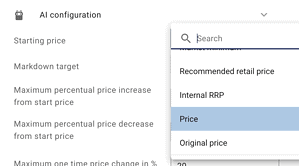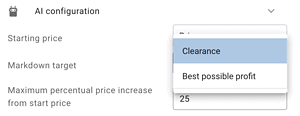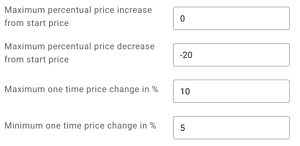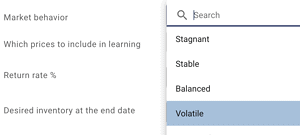Are you running an eCommerce store with items having high seasonal stocks or best before dates? With a prompt nod, you might agree that efficient stock management and effective markdown pricing processes are crucial for you success. A good example of seasonal industry is the fashion industry (case example: FAM Brands markdown pricing).
To support people in fashion and other fast perishable goods, this blog post examines the benefits of using dynamic markdown pricing. We will show a concrete example of how this can be done with Sniffie. A checklist can be found at the end of the blog post which you can use to collect tips about the process for your benefit. With these ideas you can improve stock rotation, reduce manual work and waste, and create better profitability by leveraging the best practices of dynamic markdown pricing.
The benefits of dynamic markdown pricing
Having too many items in stock and running late into the season means that you might end up with excess stock. Finding the time to analyse the best slot to set your products to markdown is hard. That is why dynamic markdown pricing can revolutionise your stock management, pricing and offer several key advantages:
Faster stock rotation
By using dynamic markdown pricing based on data-driven insights, you start pricing differently early and move products more quickly. You reduce the risk of holding onto outdated items and making a loss.
No manual work
Automation with dynamic filtering and AI guided pricing eliminates the need for constant manual monitoring on which products to set into markdown and when. In addition, running the markdown pricing campaign can be fully automated and based on AI responses on customer demand. Forget the guess work or the too lucrative price adjustments. Save your precious time, money and resources. Who wouldn’t want that?
No waste
Dynamic markdown pricing helps you avoid waste by ensuring that all items are sold before they reach their best before dates or go out of season. This is especially important if you sell expiring products, but it is sustainable no matter what you sell.
Better profitability
By optimizing your markdowns, you can generate more revenue and improve your overall profit margins.

Preparing your master data for dynamic markdown pricing automation
To lay the foundation for a successful automation in dynamic markdown pricing, it is essential to have accurate and up-to-date master data. This data will not only enable your pricing team, let alone AI-driven pricing algorithms to make informed decisions, but it will also timely process starts and endings of the strategies. Having good intentions and ideas is one thing, but getting campaigns started in the right time, is another. The latter often aligns better with your business objectives. To prepare your master data for markdown pricing automation, you should focus on these three primary components:
1. Updated inventory data
Ensuring your inventory data is updated regularly is the most important thing. The second is the descriptive attributes in your inventory data. Good attributes in your inventory data will help you create automated workflows that are easy to understand.
Inventory information is crucial for making pricing decisions, as it allows the automation system also to adjust prices based on stock availability and demand. But it is also crucial to know when the product should be put to discount or a markdown. So make it a priority to maintain a comprehensive and updated inventory data for your pricing team and real-time data into your pricing tool.
2. Daily sales data
Daily sales data is vital for your dynamic markdown pricing campaign to be successful. The faster your team or in the best-case AI-driven pricing algorithms can learn from past performance and make informed predictions about future sales trends, the better. Good and comprehensive sales data enables you the possibility to optimize your overall profitability in each campaign. In the best case your markdown campaign has started so well, that it even offers you a possibility to raise prices during the markdown to optimize the outcome. With only high quality and frequently updated data the AI algorithms can identify patterns, determine the optimal price points for different products, and react to changes in demand. Ensure that your sales data is collected daily and integrated into your pricing platform, allowing for continuous learning and improvement.
3. Marketing data (preferably)
There is no business that couldn’t improve their sales with marketing. That said marketing is also a real source for further intel for markdown campaigns. Incorporating marketing data into your pricing master dataset will provide valuable insights into how your marketing impacts sales. This data may include information on promotions, advertising campaigns, and customer engagement metrics. But it also offers you data points on when your product is about to come to the end of season. When conversions and new customer acquisition is dropping. Or maybe ROAS is showing signs of weakening. By integrating marketing data into your pricing platform, your automation system can better understand the relationships between marketing activities, demand and sales performance, enabling it to make more informed pricing decisions and start campaigns in time.
Ensure data usability
To maximize the effectiveness of your automation, it is good practice to have all your data in your pricing platform. This may involve aggregating data from multiple sources, such as your inventory management system, sales records, and marketing platforms. But rest assured, it will pay back in the automation phase. Once your master data is properly prepared and accessible by your pricing platform, you can begin creating automation strategies to optimize your markdown pricing.
Creating a dynamic markdown pricing campaign
Now that you’ve got the big picture on the requirements for the automation and the benefits of it, let’s dive into how to create those automations. We’ll show you how it works in Sniffie.
First, we must define the criteria
Creating a markdown strategy that targets specific products requires the implementation of dynamic filtering based on various criteria. In this example, we’ll delve deeper into the process of creating a filtered strategy for products that meet the following conditions:
- Stock name and type should be our own warehouse – the products should be in our own stock and not a supplier stock
- Products based on our demand forecast will not sell out the stock in more than 120 days
- Products that have more than 100 units in stock currently (could be refined also by the value of the product)
- The revenue for the last month is already low (days since last purchased >14) and,
- The new customer rate is less than 10%.
Start by clearly defining the criteria for the products you want to target with your markdown strategy.

As shown above in this example, we want to focus on products that are in stock and are stored in our warehouse. Additionally, we’re looking for items that will have a stock rotation over 120 days, and there are more than 100 units in stock, and the products generate less than 300 in revenue per month and have a new customer rate below 10%.
The reason for these filters is that we know already that products with high stock, low rotation, and low new customer rate are showing signs of coming out of season and our AI forecast is confirming that the selected products will not sell out in 120 days. So, we have our list ready.
Setting up the markdown pricing campaign in detail
At the same time, we develop a markdown pricing campaign that will automatically start and make sure we sell out the stock by the end of the campaign. This involves setting specific goals for stock clearance, profit and volume generation, and a preferred end stock level. In this case, we want all the products to be sold out by the end of the markdown.
After having your products filtered dynamically to your strategy, it is time to set up the markdown pricing campaign. This campaign will determine how the pricing automation system adjusts product prices to meet your objectives. Here’s a detailed breakdown of how to configure your markdown pricing campaign using the example settings provided:
1. Starting Price

Set the starting price for products in the campaign. You can make a price either before the markdown start or start immediately from the current price. This price point serves as the baseline from which the AI-driven pricing algorithm will make adjustments in response to various factors, such as demand, competition, and inventory levels.
2. Our Markdown Target

Choose a primary objective for your markdown campaign. In this example, the focus is on clearing inventory rather than maximizing profit. This means the pricing algorithm will prioritize moving stock quickly, even if it results in lower overall profit margins.
3. Price Adjustments

Determine the limits within which the pricing algorithm can adjust product prices. In this example, price increases from the starting price are not allowed. The maximum percentage price decrease allowed from the starting price is set at -70%, ensuring that the price will not be reduced beyond this threshold. Additionally, the maximum one-time price change is limited to -10%, preventing drastic price drops that could hurt your brand image or lead to a loss.
4. Market Behaviour

Adjust the pricing algorithm’s sensitivity to market conditions by setting the market behaviour parameter. In this example, the market behaviour is set to “Balanced” or “Volatile.” These settings allow the algorithm to learn and adapt more quickly, enabling it to respond effectively to rapidly changing market conditions or high levels of competition. Balanced setting uses more stable history combined with newer findings and the Volatile setting will emphasise more on recent findings. The shorter the campaign the more likely it is that you should choose in Turmoil.
5. Return Rates
If a product has a high return rate, include the return rate percentage in the campaign settings. This will ensure that the pricing algorithm takes the return rate into account when adjusting prices. For example, a higher return rate might signal a need for a more aggressive markdown strategy to clear inventory or might indicate issues with product quality or fit that should be addressed.

6. Desired Inventory at End Date
Set a target for the inventory level at the end of the campaign. In this example, the desired inventory is 0, meaning that the goal is to clear all stock by the campaign’s conclusion. The pricing algorithm will use this target to guide its price adjustments, aiming to achieve the desired inventory level within the campaign period.
By carefully configuring your markdown pricing campaign, you can create a data-driven, AI-powered strategy that helps you achieve your specific business objectives. The right campaign settings will enable your pricing algorithm to make smart, adaptive pricing decisions that optimize your stock management, improve customer satisfaction, and enhance your overall profitability.
Conclusion
Dynamic markdown pricing is a powerful process for any Ecommerce businesses, especially in industries with high seasonal stocks or best before dates. By leveraging the power of data and AI-driven algorithms, you can optimize your pricing strategies to improve stock rotation, reduce manual work, minimize waste, and boost profitability. With the right combination of data, dynamic filtering, and robust AI models, you can create a markdown pricing system that adapts to your unique business needs and helps you stay ahead of the competition.
FAQ
Most frequent questions and answers
Markdown pricing strategy is a plan in which retailers lower the price of a product to increase sales, clear inventory, or promote specific items. It is commonly used for end-of-season sales, discontinued products, or perishable goods nearing their best-before date. Markdown pricing strategy includes a plan on how to select, reprice and optimise products with discount pricing to make sure there is no excess stock by the end of the markdown pricing campaign.
Retailers consider several factors when determining the appropriate markdown, such as:
- Sales performance: Slow-selling or overstocked items may require more significant markdowns to attract buyers.
- Product perishability: Perishable goods nearing their best-before date may require larger discounts to ensure they sell before becoming unsellable.
- Competitor pricing: Retailers may need to match or undercut competitor prices to stay competitive.
- Seasonality: End-of-season sales often require markdowns to clear inventory for new products.
Ultimately, the ideal markdown will vary based on these factors and the retailer’s specific goals and circumstances.
A great markdown pricing example is with foods that are close to their best-before date. These items are often set to a discount campaign, with significant markdowns to encourage quick sales and reduce food waste. For instance, a $10 item with a 50% markdown would now cost $5.


